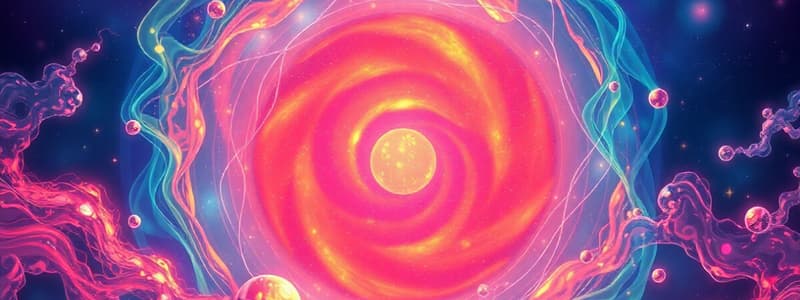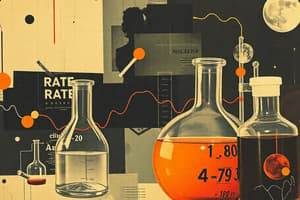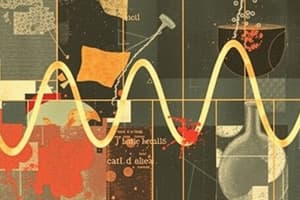Podcast
Questions and Answers
In the context of scientific investigation, why might a scientist choose to discuss their initial observations with other scientists?
In the context of scientific investigation, why might a scientist choose to discuss their initial observations with other scientists?
- To seek alternative explanations or interpretations of the observed phenomena, potentially broadening the scope of inquiry. (correct)
- To expedite the publication of their findings, leveraging the collective reputation of the scientific community.
- To establish priority over the discovery, preventing others from pursuing similar lines of investigation.
- To ensure their observations align perfectly with pre-existing theories and require no further examination.
How did the observation of Brownian motion contribute to the development of the particle theory of matter?
How did the observation of Brownian motion contribute to the development of the particle theory of matter?
- It provided evidence for the existence of individual atoms, directly observed through powerful microscopes.
- It refuted older theories that matter was static, leading to the theory of thermodynamics instead.
- It offered indirect evidence supporting the idea that fluids consist of tiny particles in constant, random motion, hitting larger particles. (correct)
- It directly demonstrated that the motion originated from an external source, disproving the necessity of a particle-based explanation.
In the sublimation of iodine experiment, what is the fundamental reason for using a cold surface (e.g., a watch glass with ice) placed above the heated iodine?
In the sublimation of iodine experiment, what is the fundamental reason for using a cold surface (e.g., a watch glass with ice) placed above the heated iodine?
- To catalyze the breakdown of iodine vapor into its constituent elements through rapid cooling.
- To provide a surface for the iodine vapor to undergo deposition, transitioning directly from gas to solid phase. (correct)
- To create a pressure gradient that forces the iodine vapor to remain in the gaseous phase.
- To absorb excess heat from the iodine vapor and prevent it from escaping into the surrounding environment.
Considering the principles of diffusion, which scenario would result in the slowest rate of mixing?
Considering the principles of diffusion, which scenario would result in the slowest rate of mixing?
In a closed system, if substance 'X' changes directly from solid to gas without passing through a liquid state, and substance 'Y' simultaneously changes from gas to solid, which of the following statements concerning energy is most accurate?
In a closed system, if substance 'X' changes directly from solid to gas without passing through a liquid state, and substance 'Y' simultaneously changes from gas to solid, which of the following statements concerning energy is most accurate?
Given that changes of state are physical changes, what is the most fundamental difference between boiling water and burning wood?
Given that changes of state are physical changes, what is the most fundamental difference between boiling water and burning wood?
Consider a scenario where you observe smoke particles under a microscope. What best describes the motion you would expect to see?
Consider a scenario where you observe smoke particles under a microscope. What best describes the motion you would expect to see?
If a pure substance transitions from a solid at its melting point to a gas without existing in a liquid state, what is the correct term for this?
If a pure substance transitions from a solid at its melting point to a gas without existing in a liquid state, what is the correct term for this?
Why is it more difficult to see individual atoms even with the most powerful microscopes?
Why is it more difficult to see individual atoms even with the most powerful microscopes?
Steam, clouds, and breath on a cold day all involve water in different states. In each case, what is happening to the water as it transforms into these visible forms?
Steam, clouds, and breath on a cold day all involve water in different states. In each case, what is happening to the water as it transforms into these visible forms?
Flashcards
Observation
Observation
Scientists study something that they don't understand.
Making a hypothesis
Making a hypothesis
Scientists ask a question about what they are observing.
Making a prediction
Making a prediction
Scientists predict an answer to the question.
Planning the experiment(s)
Planning the experiment(s)
Signup and view all the flashcards
Collecting and analyze data
Collecting and analyze data
Signup and view all the flashcards
Drawing conclusions
Drawing conclusions
Signup and view all the flashcards
Peer-review
Peer-review
Signup and view all the flashcards
Refine experiments
Refine experiments
Signup and view all the flashcards
Publication
Publication
Signup and view all the flashcards
Brownian motion
Brownian motion
Signup and view all the flashcards
Study Notes
- Chemical kinetics involves reaction rates, rate laws, temperature dependence, catalysis, and reaction mechanisms.
Reaction Rate
- It is the change in reactant or product concentration over time.
- For $aA + bB \rightarrow cC + dD$, Rate $= -\frac{1}{a} \frac{\Delta[A]}{\Delta t} = -\frac{1}{b} \frac{\Delta[B]}{\Delta t} = \frac{1}{c} \frac{\Delta[C]}{\Delta t} = \frac{1}{d} \frac{\Delta[D]}{\Delta t}$
- $[A]$, $[B]$, $[C]$, $[D]$ represent reactant and product concentrations.
- $a$, $b$, $c$, $d$ are stoichiometric coefficients.
- $\Delta t$ is the change in time.
Rate Law
- The rate law equation relates reaction rate to reactant concentrations raised to specific powers.
- General form: Rate $= k[A]^m[B]^n$.
- $k$ is the rate constant.
- $m$ and $n$ are reaction orders with respect to A and B.
- Overall reaction order: $m + n$.
- Reaction orders are determined experimentally.
Common Rate Laws
- Zero-Order: Rate = k, rate is independent of reactant concentration.
- First-Order: Rate = k[A], rate is directly proportional to reactant concentration.
- Second-Order: Rate = k[A]^2 or Rate = k[A][B], rate is proportional to the square of one reactant's concentration or the product of two reactant concentrations.
Temperature Dependence via Arrhenius Equation
- The Arrhenius Equation links the rate constant k to temperature T: $k = Ae^{-\frac{E_a}{RT}}$.
- A is the pre-exponential factor.
- $E_a$ is the activation energy.
- R is the gas constant, equal to 8.314 J/(mol⋅K).
- T is absolute temperature in Kelvin.
Activation Energy
- $E_a$ represents the minimum energy for a reaction to occur.
- Higher $E_a$ results in a slower reaction rate.
Catalysis
- A catalyst speeds up a chemical reaction without being consumed.
- Homogeneous catalysis: catalyst is in the same phase as reactants.
- Heterogeneous catalysis: catalyst is in a different phase from reactants.
Reaction Mechanisms
- A reaction mechanism includes a series of elementary steps from reactants to products.
- Elementary step: A single step in a reaction mechanism, the rate law can be deduced from stoichiometry.
- Rate-determining step: the slowest step in a reaction mechanism, determines the overall reaction rate.
Algorithmus von Floyd-Warshall
Ziel
- Findet die kürzesten Pfade zwischen allen Knotenpaaren in einem Graphen.
Eingabe
- Graph $G = (V, E)$ mit Kantengewichten $w: E \rightarrow \mathbb{R}$.
- Adjazenzmatrix $D = (d_{ij})$ mit $d_{ij} = w(i, j)$ , $d_{ij} = \infty$, $d_{ij} = 0$.
Ausgabe
- Distanzmatrix $D^* = (d_{ij}^)$, wobei $d_{ij}^$ die Länge des kürzesten Pfades von Knoten $i$ zu Knoten $j$ ist.
Algorithmus
- For k in 1 to |V|: For i in 1 to |V|: For j in 1 to |V|: D[i][j] := min(D[i][j], D[i][k] + D[k][j])
Eigenschaften
- Korrektheit: Finds shortest paths if no negative cycles exist.
- Laufzeit: (\Theta(|V|^3))
- Speicherplatz: (\Theta(|V|^2))
Beispiel
- Graphen: (1)->(2)->(3), (3)->(1).
- Adjazenzmatrix: $D = \begin{bmatrix} 0 & 2 & \infty \ \infty & 0 & 3 \ 4 & \infty & 0 \end{bmatrix}$
- Distanzmatrix: $D^* = \begin{bmatrix} 0 & 2 & 5 \ 7 & 0 & 3 \ 4 & 6 & 0 \end{bmatrix}$
Anmerkungen
- Works with negative weights if no negative cycles.
- Negative cycles are found if $D[i][i] < 0$.
Lecture 24: Photodiodes
Light as a Source of Energy
- Electron-hole pairs are generated when light shines on a semiconductor material.
- Electron-hole pairs recombine without a field
- Separation of electron-hole pairs by a potential barrier creates a voltage.
Device & Circuit Operation
- A photodiode collects light-generated carriers efficiently.
- Light-generated carriers are collected to produce current under reverse bias.
- Operated in reverse bias, current increases linearly with light intensity.
Photodiode Structure
- Basic Structure: p-n junction, light shone on intrinsic region, light is absorbed creating electron-hole pairs.
- Improved Structure: p-i-n photodiode increases absorption volume.
Current Gain
- Responsivity ((\Re)): Ratio of photocurrent ((I_{ph})) to incident optical power ((P_{opt})): (\Re = \frac{I_{ph}}{P_{opt}}).
- Quantum Efficiency ((\eta)): Number of electron-hole pairs per incident photon: (\eta = \frac{I_{ph}/q}{P_{opt}/hv})
- Avalanche Gain (M): Due to impact ionization, where (M = \frac{I_M}{I_{ph}}).
Key Performance Parameters
- Includes Responsivity, Speed, Dark Current, Noise, Capacitance.
Advantages & Disadvantages
- Advantages: High sensitivity, fast response, low noise, small size, low cost.
- Disadvantages: Temperature dependence, dark current, capacitance, fragility.
Applications
- Light detection, measurement, optical communication, medical imaging, bar code scanners, optical storage, remote control.
Guía de inicio rápido de Markdown
- Markdown: Texto plano con sintaxis de formato ligero.
Sintaxis de Markdown
Encabezados
- From # Encabezado 1 to ###### Encabezado 6.
Énfasis
- Cursiva, Negrita, Negrita Cursiva.
Listas
- Ordenada: 1. Primer elemento, 2. Segundo elemento; No ordenada: * Primer elemento, * Segundo elemento.
Enlaces
Imágenes
- .
Citas
- > Esto es una cita.
Código
- En línea:
printf(); Bloque: ```...code...```.
Tablas
- Using | Encabezado 1 | Encabezado 2 |.
Líneas horizontales
- ---.
Fórmulas matemáticas
- En línea: (x=y+2); Bloque: [f(x) = ...].
Combinación de elementos
- Combina to create richer documents.
Chemical Kinetics Formulae
Reaction Rate
$aA + bB \rightarrow cC + dD$
- Rate $= -\frac{1}{a} \frac{d[A]}{dt} = -\frac{1}{b} \frac{d[B]}{dt} = \frac{1}{c} \frac{d[C]}{dt} = \frac{1}{d} \frac{d[D]}{dt}$
Rate Law
- Rate $\propto [A]^x [B]^y$
- Rate $= k[A]^x [B]^y$
- x + y = overall order of reaction
Zero Order Reaction
- Rate $= k[A]^0 = k$
- $[A] = [A]_0 - kt$
- $t_{1/2} = \frac{[A]_0}{2k}$
First Order Reaction
- Rate $= k[A]^1 = k[A]$
- $\ln[A] = \ln[A]_0 - kt$
- $t_{1/2} = \frac{0.693}{k}$
Second Order Reaction
- Rate $= k[A]^2$
- $\frac{1}{[A]} = \frac{1}{[A]_0} + kt$
- $t_{1/2} = \frac{1}{k[A]_0}$
Arrhenius Equation
- $k = A e^{-E_a/RT}$
- $\ln(\frac{k_2}{k_1}) = \frac{E_a}{R} (\frac{1}{T_1} - \frac{1}{T_2})$
- Ea = activation energy, R = 8.314 J/mol·K, A =frequency factor
Productos notables
Binomio al cuadrado
- ((a+b)^2 = a^2 + 2ab + b^2)
- ((a-b)^2 = a^2 - 2ab + b^2)
Binomios conjugados
- ((a+b)(a-b) = a^2 - b^2)
Binomio con término común
- ((x+a)(x+b) = x^2 + (a+b)x + ab)
Binomio al cubo
- ((a+b)^3 = a^3 + 3a^2b + 3ab^2 + b^3)
- ((a-b)^3 = a^3 - 3a^2b + 3ab^2 - b^3)
Factorización
Factor común
- (ab + ac = a(b+c))
Diferencia de cuadrados
- (a^2 - b^2 = (a+b)(a-b))
Trinomio cuadrado perfecto
- (a^2 + 2ab + b^2 = (a+b)^2)
- (a^2 - 2ab + b^2 = (a-b)^2)
Trinomio de la forma (x^2 + bx + c)
- (x^2 + bx + c = (x+p)(x+q)), where (p+q = b) and (pq = c)
Suma o diferencia de cubos
- (a^3 + b^3 = (a+b)(a^2 - ab + b^2))
- (a^3 - b^3 = (a-b)(a^2 + ab + b^2))
Markdown Quick Start Guide
What is Madown?
- Markdown: a lightweight markup language with plain text formatting syntax.
- Markdown is not a replacement for HTML, it is simply a way to format the text on the web
- Madown can be use it for almost everything
Syntax
Headers
-
Header 1 ### lists
lists
ordered lists
- write the code:
1. First item
2. Second item
3. Third item
- This is the the output:
- First item
- Second item
- Third item
unordered lists
- write the code:
- First item
- Second item
- Third item
- This is the the output:
- First item
- Second item
- Third item
Emphasis
- Write the code:
- italic text*
_italic text_
- *bold text**
__bold text__
- **bold and italic text***
___bold and italic text___
- This is the the output:
- italic text* italic text
- bold text* bold text
- bold and italic text* bold and italic text
Links
- Write the code:
[Link text](url)
- This is the the output: Link text
Images
- Write the code:

- This is the the output: 
code
inline
- Write the code:
Use the funcition `printf()`
- This is the the output:
Use the funcition
printf()
blocks
- Write the code:
` ``python
s = "hello world!"
print s
` ``
- This is the the output:
s = "hello world!"
print s
quotations
- Write the code:
> A good phrase
- This is the the output:
A good phrase
Horizontal rules
- Write the code:
- --
- This is the the output:
Tablas
- Write the code:
| head1 | head2 |
| ----------- | ----------- |
| cell1 | cell2 |
| cell3 | cell4 |
- This is the the output:
| head1 | head2 |
|---|---|
| cell1 | cell2 |
| cell3 | cell4 |
additionals resources
- Write the code: markdown syntax guide
- Write it online: online markdown editor
Static Equilibrium Study Notes
Objectives
- Study the conditions for static equilibrium.
- Verify that the vector sum of forces is zero.
- Verify that the sum of the torques is zero.
Key Definitions
- Static equilibrium means the object is at rest and remains at rest with zero translational and rotational acceleration.
Translational Equilibrium
- Vector sum of the forces must be zero: (\sum \overrightarrow{F} = 0)
Rotational Equilibrium
- Sum of the torques must be zero: (\sum \tau = 0.)
- Torque Formula: (\tau = rF\sin\theta )
- r = distance from axis of rotation to the point where the force is applied.
- F = magnitude of the force.
- θ = angle between the force vector and the vector from the axis of rotation to the point where the force is applied.
Procedure
- Part 1 covers translational equilibrium.
- Part 2 covers rotational equilibrium.
Data Analysis
Translational Equilibrium:
- Magnitude of the force using: (F = \sqrt{F_x^2 + F_y^2}).
- Direction formula: (\theta = \arctan(\frac{F_y}{F_x})).
Rotational Equilibrium:
- Torque formula: (\tau = rF\sin\theta).
Questions:
- Difference between static and dynamic?
- Conditions for static equilibrium?
- Torque calculation and units?
- Possible sources of error in each experiment?
Studying That Suits You
Use AI to generate personalized quizzes and flashcards to suit your learning preferences.




